Travel: Bukhara to Samarkand , Uzbekistan May 12-13/2025
- Lili Naveh
- May 13
- 10 min read
Updated: Jul 6
A continuation of a guided tour to Uzbekistan which started on May 7th
TLV to Tashkent. 5/8-9 (here)
Tashkent 5/8-9 (here)
Khiva. 5/9 (here)
Bukhara 5/10-11 (here)

Samarkand was the last city, visited during this trip, on the famous Silk Road
the network of Asian trade routes active from the 2nd BC until the mid-15th C and spanning over 6,400 km (4,000 mi),
It played a central role in facilitating economic, cultural, political, and religious interactions between the Eastern and Western worlds.

The pleasant ride by train from Bukhara further East, took 2.5 hours. through the Samarkand region
History of Bukhara Railway Station dates back to the early 19th C, when the Trans-Caspian railway was built in Central Asia
Samarkand

Samarkand, the capital of the Samarkand Region has been among the oldest continuously inhabited cities in Central Asia. ,
The name comes from the Iranian languages Persian and Sogdian samar "stone, rock" and kand "fort, town.
With about 600,000 inhabitants it is the third-largest city in Uzbekistan In 2001, UNESCO added the city to its World Heritage List as Samarkand – Crossroads of Cultures.
Modern Samarkand is divided into two parts: the old city, which includes historical monuments, shops, and old private houses; and the new city, which was developed during the days of the Russian Empire and Soviet Union and which includes administrative buildings along with cultural center and educational institutions.
It is speculated from its location on the Silk Road between China, Persia and Europe, that the city was founded between the 8th and 7th BC , and at times Samarkand was one of the largest[ cities in Central Asia, an important city of the empires of Greater Iran
The city was conquered by Alexander the Great in 329 BC, when it was known as Markanda, and after it was ruled by a succession of Iranian and Turkic rulers, until it was conquered by the Mongols under Genghis Khan in 1220.

The city is noted as a center of Islamic scholarly study and the birthplace of the Timurid Renaissance., in the 14th C
Timur made it the capital of his empire and the site of his mausoleum, the Gur-e Amir.

Timor/ Tamerlan, Empire (1320s – 1405)
This Turco-Mongol decent conqueror, who shared a common ancestor with Genghis Khan on his father's side, was born into the -Uzbekistan in the 1320s.
He founded the Timurid Empire in and around modern-day Afghanistan, Iran, and Central Asia,
He become the first ruler of the Timurid dynasty. and was an undefeated commander, widely regarded as one of the greatest military leaders and tacticians in history, as well as one of the most brutal and deadly. killing 17, million throughout the lands.

Timor clearly sought to invoke the legacy of Genghis Khan's conquests during his lifetime. envisioning the restoration of the Mongol Empire. According to Gérard Chaliand, saw himself as Genghis Khan's heir
From his conquests that started with small band of followers who raided travelers for goods, especially animals such as sheep, horses, and cattle troops, and who were mostly Turkic tribesmen of the region, he founded the Timurid Empire,
To legitimize his conquests Timur relied on Islamic symbols and language, referring to himself as the "Sword of Islam".
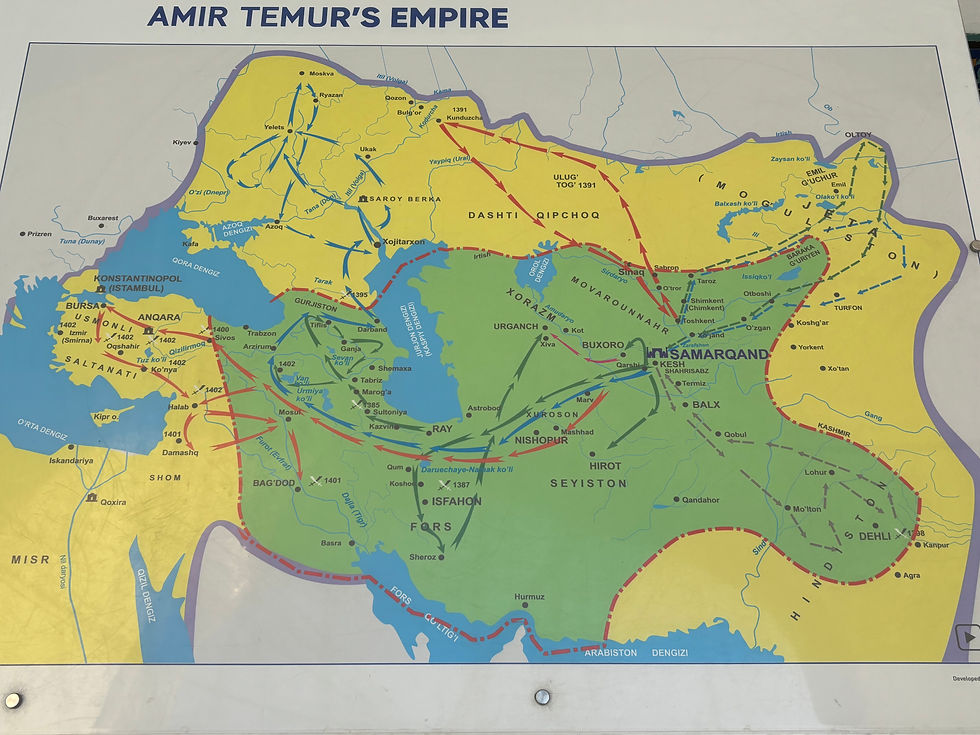
Timur's armies were inclusively multi-ethnic and were feared throughout Asia, Africa, and Europe. Sizable parts of his campaigns laid waste. and have been characterized as genocidal. causing the deaths of millions of people.
Timur gained control of the western Chagatai Khanate by 1370. and from that base he led military campaigns across Western, South, and Central Asia, the Caucasus, and Southern Russia.
Defeating in the process the Khans of the Golden Horde, the Mamluks of Egypt and Syria, the emerging Ottoman Empire, as well as the late Delhi Sultanate of India, he became the most powerful ruler in the Muslim world. building an empire which fragmented shortly after his death.
Timur spoke several languages and was also considered a great patron of of educational and religious institutions. as well as of art and architecture, for he interacted with intellectuals such as Ibn Khaldun, Hafez, and Hafiz-i Abru
Timur had forty-three wives and concubines, all of these women were also his consorts. He was the last of the major nomadic conquerors of the Eurasian Steppe, and his empire set the stage for the rise of the more structured and lasting Islamic gunpowder empires in the 16th and 17th C.
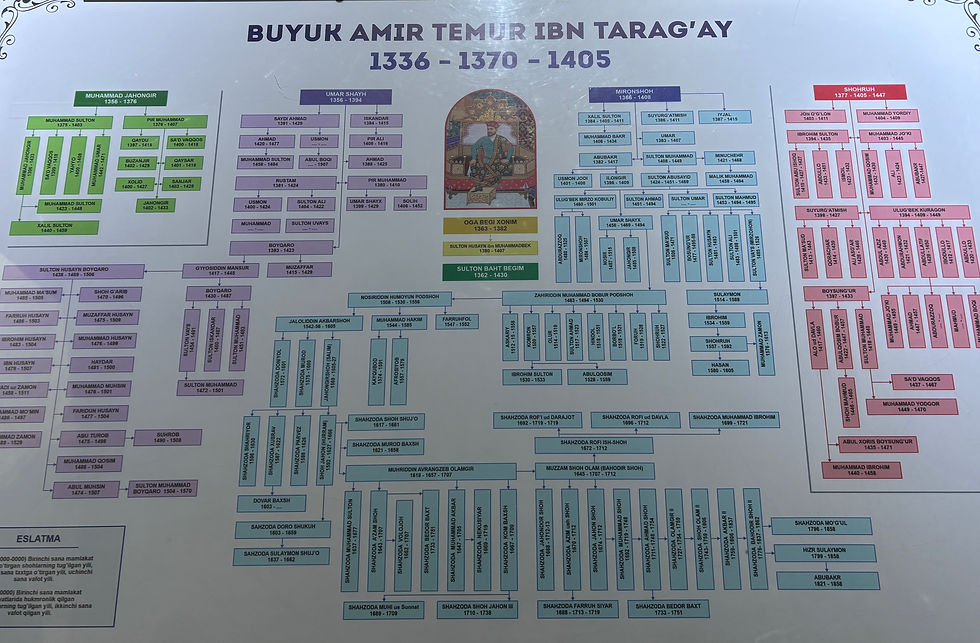
Timor -the Father of the Nation was the grandfather of the Timurid sultan, astronomer and mathematician Ulugh Beg, who ruled Central Asia from 1411 to 1449, and the great-great-great-grandfather of Babur (1483–1530), founder of the Mughal Empire
Gur e- Amir Mausoleum of Tamerlane - "Tomb of the King"

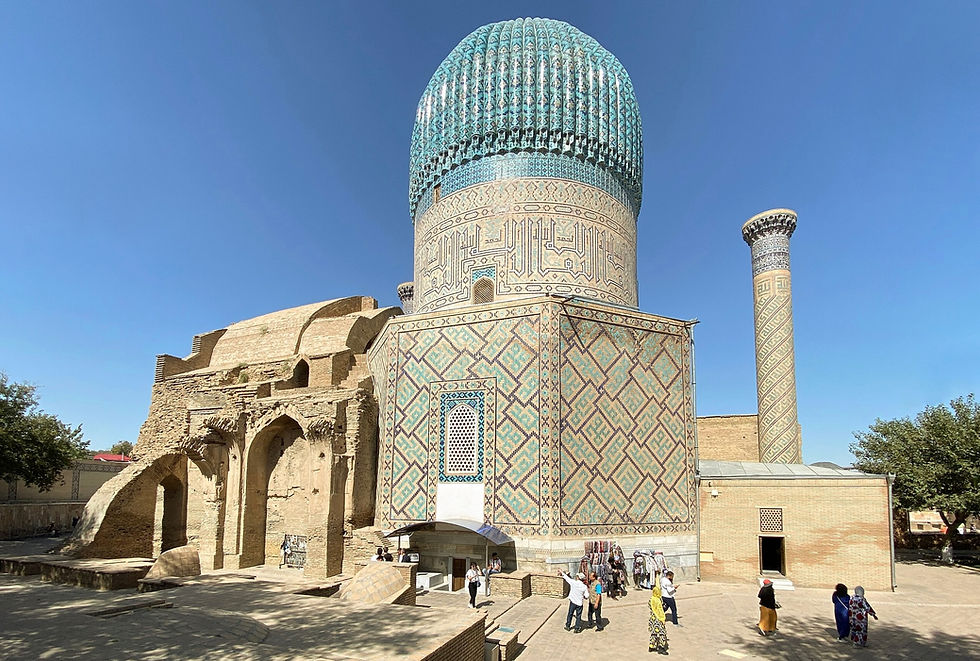
This masterpiece architectural complex of Islamic Timurid era with its Syrian inspired azure dome which occupies an important place in the history of world Islamic architecture., was inspired from many other places Timor conquered

The complex contains the tombs of Timur, his sons Shah Rukh and Miran Shah and grandsons Ulugh Beg and Muhammad Sultan. It includes also the tomb of Timur's teacher Sayyid Baraka.
Timur ordered for his grandson the building of a mausoleum, which became the family tomb of Gur-e-Amir. The mausoleum was built in the southeastern part of medieval Samarkand, near the madrasa and khanqah of Muhammad Sultan.
The earliest part of the complex was built at the end of the 14th C by the orders of Muhammad Sultan, Isfahani - Timur's heir to the throne, a native of the Iranian city of Isfahan. but only after his sudden death ,
The mausoleum has been heavily restored over the course of its existence.
The entrance portal to the Muhammad Sultan ensemble is richly decorated with carved bricks and various mosaics. All the extensions of Ulugh Beg's time are attributed to the architect Muhammad ibn Mahmud from Isfahan.

After his Indian campaign[in 1399, Timur decided to construct a gigantic mosque in his new capital, Samarkand. It was one of the most important monuments of Samarkand, Uzbekistan. In the 15th C, being a masterpiece of the Timurid Renaissance and the largest and most magnificent mosques in the Islamic world.

Timur named the mosque after his wife, Saray Mulk Khanum. Another version tells that the Bibi Khanym Mosque was actually commissioned by the wife herself
By the mid-20th C only a grandiose ruin of Bibi-Khanym Mosque, still survived ,It was rebuilt during the Soviet era, and has remained one of the city's most notable landmarks.
Samarkand's Registan square - "sandy place" or "desert"

The impressive square was the city's ancient heart, a public center, the hub of the Timurid Empire. People gathered at the square to hear royal proclamations, heralded by blasts on enormous copper pipes called dzharchis — and it was a place of public executions. as well as a place to collect the army leaving to war.

This grand architectural ensemble a voyage through history, is breathtaking and has earned it global fame as a monument of oriental architecture,and cultural heritage.
This central square which was In the ancient times, covered by sand. and transformed, now a days serves as museum tourist site.
In the past, one could see many trade rows around the square, where artisans and farmers were selling their goods. All main roads of Samarkand led to Registan where it was always noisy and lively..
A masterpiece of the Timurid Renaissance. the square is framed by 3 monumental religious buildings. -madrasahs ( schools) of distinctive Persian architecture,.portals
of which are facing the center of the space. each having their own unique décor., and earning the city a place the UNESCO World Heritage List in 2001
Ulugh Beg Madrasa Sher-Dor Madrasah Tilya-Kori Madrasah (

The Ulugh Beg Madrasah (1417–1420), - the first madrasa erected on the Registan Square, with imposing iwan and a lancet-arch pishtaq portal,. one of the best clergy universities of the Muslim Orient in 15c
The heir of the great state of the Temurids, a well-known mathematician and astronomer Ulugh Beg, assumed the authority in 1409. In year 1417, he gave an order to build the madrasa that would later be renamed in his honor. Ulugh Beg himself gave lectures there
The museum's artifacts on display inside of the madrasa

The Sher-Dor Madrasah (1619–1636), Tiger mosaics with a rising sun characterize it
Being a ruler of the city, In 1612, Yalangtush Bahadur appointed as the emir of Samarkand, a skillful politician and an educated commander. he decided to construct another madrasa on the Square opposite the building erected by Ulughbek

The Tilya-Kori Madrasah (1646–1660). "Gilded" a residential college for students, that also played the role of grand masjid. 10 years later the same ruler of Samarkand Yalangtush Bahadur planned to erect another building that was supposed to complete the ensemble on the square.on the place of the caravan-sarai.
To the east of the Tilya-Kori Madrasah, the mausoleum of Shaybanids (16th C) is located
By Registan Square

Following the visit to the majestic Registan's architectural splendor, - a true feast to the eye, frequenting the mundane, yet liveliest Siob Bazaar, satiated also the taste's buds.

Siyob Bazaar, - Black water/river.
Located adjacent to the Bibi-Khanym Mosque, this largest bazaar in Samarkand, is one of the most visited places in the city.
The main entrance has an impressive triple arch lined with blue majolica
The bazaar's name comes from one of the historical and geographical regions of the city - Siyob, and the Siyob River flowing near the bazaar.

The complex consists of 7 large covered pavilions with counters, as well as several other large shopping arcades pavilions. Trading rows are under tents that protect the bazaar from a burning sun in summer and from wind and rain in winter.
Its wide selection of dried fruits, roasted salty nuts and seeds , are one of the best I have ever sampled, and is worth stocking on.

Near the bazaar is located also – Hazrat Khizir Mosque. associated with the legendary Islamic prophet Hazrat Khizr. - who was one of the Muslim saints, patron of travelers, and responsible for water resources and wealth. The name in Arabic means "green light", ie "Living".
The mosque which was built in the 8th C is one of the oldest Muslim religious buildings in Samarkand. built on the hill at the entrance to the city, Close to the band, appeared much later Shahi Zinda mausoleums and Siyob market.
It was destroyed in the 12C I c. by horde of Genghis Khan. later restored and rebuilt several times, and its today's appearance is from the 19thC..
Shahi Zinda Mausoleum Complex - "The Living King".


This burial place of royal persons and nobles. of Tamerlane's relatives, is one of the most mysterious and unique architectural monuments of Samarkand,

The Shah-i-Zinda complex was formed over eight centuries (from the 11th until the 19th) and now includes more than twenty buildings comprises three groups of structures: lower, middle and upper and connected by four-arched domed passages locally called chartak.
It consists of harmoniously combined rows of refined, sparkling blue tombs.composition, eleven mausoleums grouped along the narrow medieval streets..that were built one after another in 14 - 15th c


The main mausoleum from which the necropolis starts seems to be the imaginary grave of Prophet Muhammad's cousin, Qutham ibn Abbas, who was one of those who came to Samarkand with the Arab invasion in the 7th c to preach Islam in that region
Later the Complex became an important pilgrimage center that was revered by the people as sacred. Each mausoleum is a square building with a dome, the entrance to which is highlighted by a portico. Is rich in architectural decoration of buildings, with used irrigation bricks, majolica tiles, carved mosaic.

The last construction is the main entrance to the crypt Shakhi Zinda, which completes the whole ensemble. The inscription on the main entrance reads: "This magnificent building created Abdulazizhanom-son Ulugbek-Guragana, son of Shah Rukh, son of Amir Timur-Guragana in 838 year (1434/35 AD).
Those who missed the chance to view and buy authentic oriental carpets, had another opportunity to visit an historic Carpet Factory

Samarkand Bukhara Silk Carpets
Abdulahad Badghisi - General Manger
(998 90) 1000777. , (998 91) 5555520. hadghisia@hotmail.co,
W0rkshope. : 12 A. Hujom St. 140132
Producer of silk & Wool natural vegetable dyed Hand Made Rugs &Embroidery Suzami)
The history of carpet weaving in the Badghisi family goes back 200 years, to the city of Mari in Turkmenistan. It is a skill spanning six generations, and one that the family carries on today
Classic Music Concert Surprise

On the last night of our stay in exotic Samarkand, a delightful Musical Event surprise was planed for the group, inside a beautiful Mosque, now used for cultural events, art exhibitions and musical concerts

+998 93 338 97 57. , +998 91 555-95-59
An amazing Vocalist Soprano Opera Singer a Flutist and Piano Player
gave a concert to only our coup in a beautifully renovated traditional mosque structure
Silk Road Samarkand Tourist Complex
Silk Road Samarkand - Tourist Complex is a new multi functional gated development opened in 2023, and which is located about 8 km away from Samarkand old city center, The group was lodged. here for 2 nights.

The Entry bridge over the Rowing Canal into this new complex
Samarkand Rowing canal was built at the end of last century at the outskirts of Samarkand, in the Silk Road tourist complex.. Its length is 2215 meters, 130 meters in width and is situated 702 meters above the sea level used for kayak and canoe rowing training and tournaments
This complex which occupies 17 hectares, accurately recreated in medieval traditional architectural style, capture the spirit of the ancient city backed up by the history and traditions of Uzbek lands and Uzbek people, It offers, the Eternal City caravanserai luxury hotels, a spacious congress center, various restaurants, and 40 ethnic craft shops.

Restaurants we sampled at this area

55)705-05-03
JWWP+GHW, Gagarin St, Samarkand, Samarqand Region
2 floors place accommodate also larger events.
Food is far from being great
Last night dinning

Boqiy Shahar - Restaurant
Tourist Complex Samarkand
M336+PJV, Samarkand,

The Afrosiyob Hilton Garden Inn we stayed at, next to the Rowing Canal, Samarkand Touristic Center opened in Feb 2024.

The Eternal City, a recreated ancient town, is part of a larger rebranding effort within the Silk Road Samarkand complex, which also saw the rebranding of Samarkand Regency Amir Temur as the Hilton Samarkand Regency and Wellness Park Hotel Sogd as the Hilton Garden Inn Sogd
And with this visit to Samarkand the last city toured, the group's visit came to its end


Departing Samarkand and returning safely back to Israel on May 14
THE END















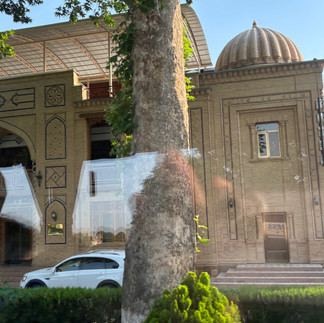





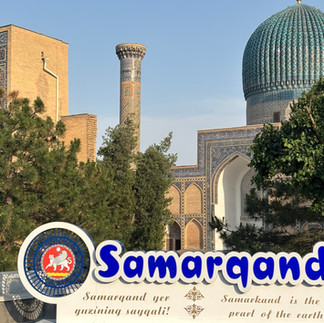













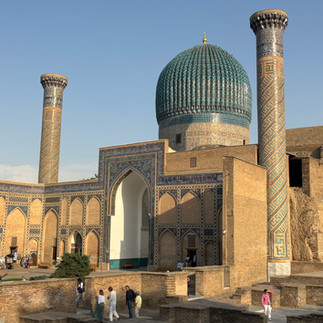







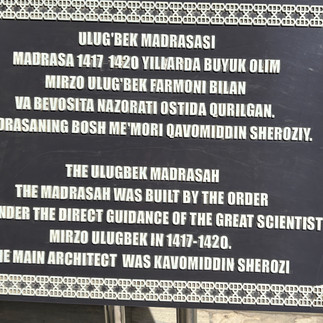



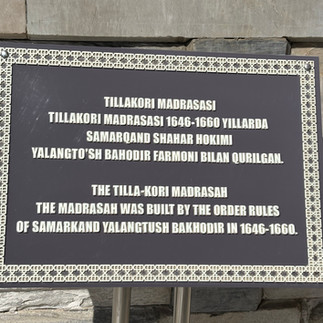





































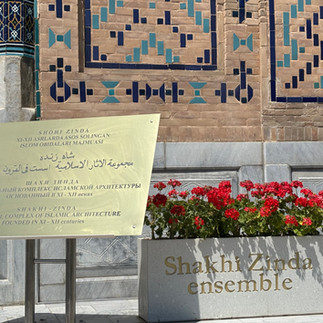





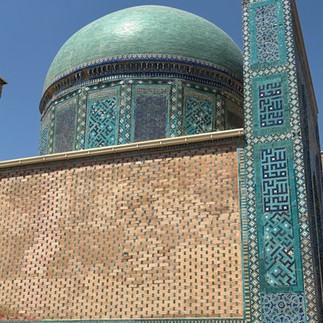























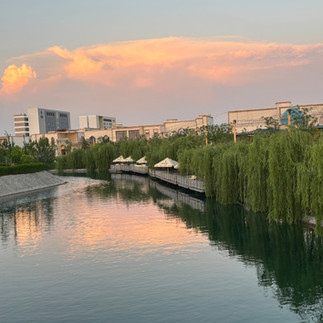







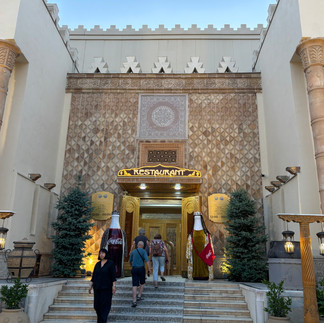

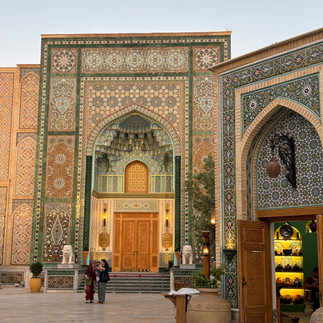













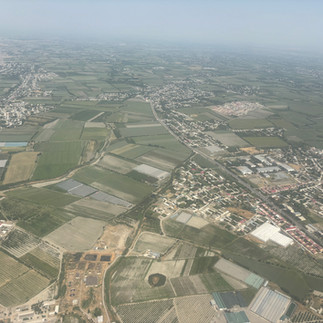







Comments